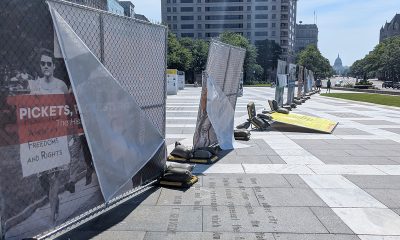a&e features
Blade’s 50-year history reflects struggles, advances of LGBT community
‘Paper of record’ chronicled police entrapment and blackmail, AIDS epidemic, marriage
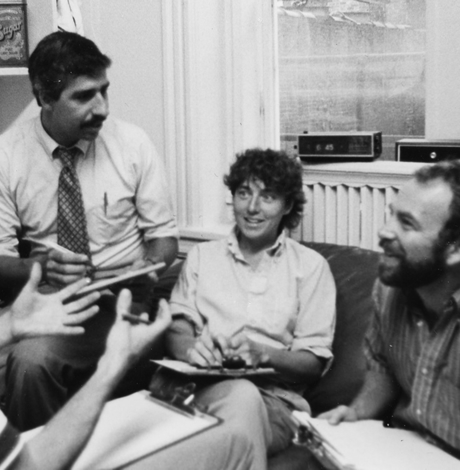
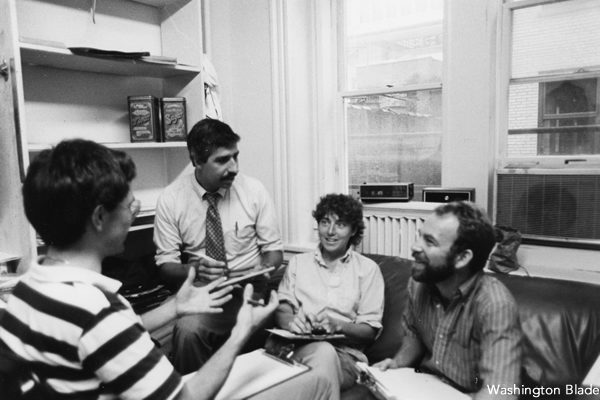
In its 50-year history, the Washington Blade has covered news for the LGBT community that has reflected dramatic advances as well as struggles ranging from workplace discrimination and attempts at blackmail to the AIDS epidemic and the achievement of marriage equality, establishing the Blade’s reputation as the LGBT newspaper of record.
In its very first issue in October of 1969 as a one-page monthly newsletter called “The Gay Blade,” the paper reported on the 1960s era fear of blackmail and the possibility of being fired from a government job because of one’s sexual orientation.
“Warning to Dupont Circle people,” the first issue states in its third story. “Cars seen too frequently in the Circle area are having their license numbers taken down; their owners later are being harassed and blackmailed.”
That same first issue included articles on pioneering gay rights activist Frank Kameny being available to provide help for gays or lesbians subjected to a security check by their employer, the formation of the Gay Liberation Front in New York City, and the launching by the Gay Blade of a gay roommate referral service.
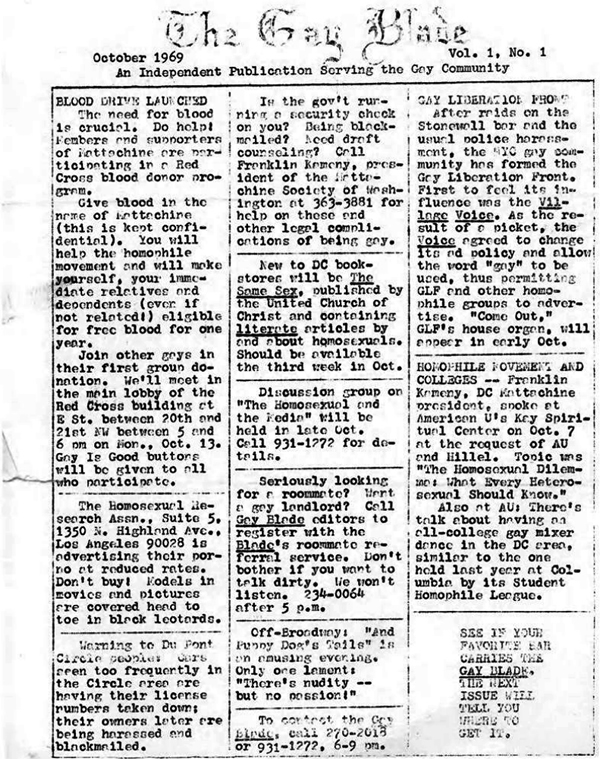
Fifty years later, the now weekly Washington Blade has a correspondent accredited to cover the White House and presidential news conferences and an editor-reporter who frequently travels abroad to cover international LGBT news.
Since September 1995, the Blade has been available online through its website, enabling it to publish breaking LGBT news on a daily and even an hourly basis.
The Blade’s founding editors in October 1969 were Nancy Tucker, a lesbian, and Bart Wenger, a gay man who at the time went by the name Art Stone. Both had been members of the Mattachine Society of Washington, the first D.C. gay rights organization of note co-founded by Kameny.
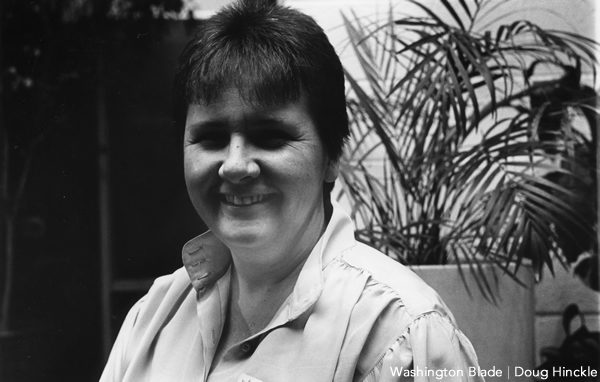
Tucker and Wenger have said in subsequent years that although they supported the work of the Mattachine Society, they wanted to launch, four months after the Stonewall riots in New York, an independent news publication to provide needed information for D.C.’s then fledgling gay rights movement.
It was Kameny, Tucker told the Blade years later, who convinced her to help produce the new publication.
“It filled a clear need right from the get-go – and it has been that way ever since,” Kameny recalled in an October 2009 interview with the Washington Blade, two years before his passing in 2011.
Tucker, who later moved to Albuquerque, N.M., has said several people were involved in producing the Blade’s first issue, including Martha Taylor, her partner at the time, who operated a mimeograph machine that printed the first 500 copies of the paper.
But she said many of the people that helped produce and distribute the first issue and the next few issues withdrew from participation a short time later, leaving only a small “staff,” all of whom were volunteers.
“It eventually came down to my doing all of the writing, most of the news work, some of the distribution, all of the advertising selling – and Bart did some of the distribution and let me know what news tips that he came up with,” Tucker said.
She said she knew the Blade was becoming influential because LGBT people were using the Blade to publicize the activities of their organizations or businesses.
“I have a profound belief that it contributed to really the creation of the gay community in Washington,” Tucker said. “It helped publicize various bars and businesses and stuff as they opened.”
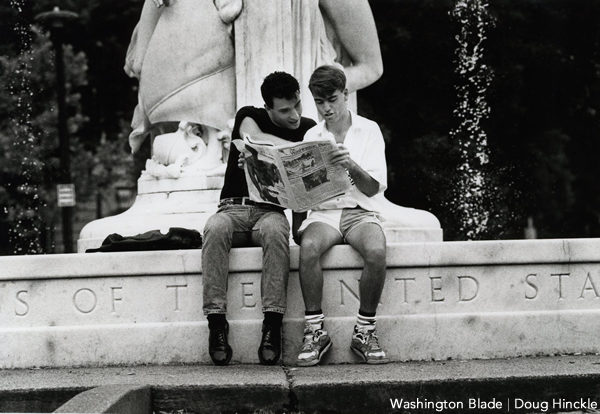
In July 1973, Tucker announced she was stepping down from her role as editor and publisher of the Blade and issued a call for interested parties to assume control of the then newsletter. Lesbian activist Pat Price, who used the pseudonym Pat Kolar, answered that call and became the new editor and publisher.
Although she and others who began to write for the Blade used pseudonyms, their names appearing in the paper marked the first time stories contained bylines. A little over one year later in November 1974 the Blade ended its newsletter size page and began publishing as a standard tabloid format on newsprint paper. Also in November 1974 the paper moved into its first offices at 1724 20th St., N.W. in Dupont Circle.
In December 1974, Joseph Crislip, who began writing for the Blade one month earlier under the pseudonym Christian Deforrest, assumed the position of Blade editor and “coordinator” of its business operations. In November 1975, under Crislip’s leadership, the Gay Blade officially changed its name to the Blade and incorporated as a nonprofit corporation called Blade Communications, Inc.
In early 1977, shortly after the Blade had moved to a two-room suite on the 2400 block of Pennsylvania Avenue, N.W, a gay activist who had recently moved to D.C. from Buffalo, N.Y. named Don Michaels showed up at a Blade volunteer meeting. It was the start of Michaels’ 24-year association with the Blade in which he would eventually become publisher and oversee the Blade’s growth in size and status to become one of the nation’s major LGBT publications.
According to a detailed account of the Blade’s history by D.C.’s Rainbow History Project, in 1978 Michaels became managing editor while Crislip retained the position of publisher. That same year, in November, the Blade changed from operating as a monthly to a bi-weekly newspaper in response to the growth in its readership and advertising.
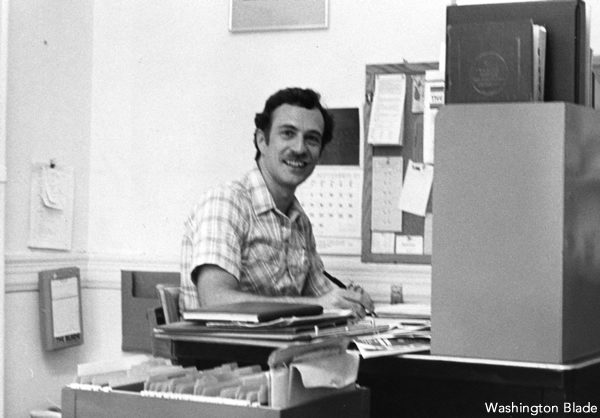
In October 1980, the Blade reincorporated into a for-profit, employee-owned business and changed its name to the Washington Blade. By early 1982 Michaels assumed the position of publisher succeeding Crislip, and as the paper continued to grow, the decision was made to become a weekly. Steve Martz, who joined the Blade a few years earlier in the advertising department, became managing editor and Lisa Keen, who started at the Blade in 1979 as a freelance reporter, became assistant editor.
From several years prior to that time up until 2001, the Blade had moved to several different locations, including 930 F St., N.W., an office building that became home on its first floor to the 9:30 Club; and later to a small office building at 724 9th St., N.W. It was during that time, around 1984 that Martz left the Blade and Keen assumed the role as top editor, which eventually was given the title of executive editor while Michaels continued as publisher.
In 1992, the Blade moved to 1408 U St., N.W., in the city’s newly developing “U Street corridor” that quickly evolved into an entertainment district. One year later, in April 1993, coinciding with the 1993 LGBT March on Washington that brought tens of thousands to the nation’s capital, the Blade published its largest issue to date, containing 216 pages.
In 1995, the Blade launched its website, WashingtonBlade.com, further expanding its ability to cover breaking LGBT news on a daily basis.
In May 2001, a gay-owned media company named Window Media that also owned the Southern Voice LGBT newspaper in Atlanta, purchased the Blade. William Waybourn, one of its principal owners, became the Blade’s new publisher and Chris Crain, another Window Media owner, became the Blade’s executive editor.
Michaels, Keen, and others on the Blade’s editorial and management leadership team left the Blade at the time of the sale. In 2006, Waybourn and Crain left the Blade to pursue other endeavors.
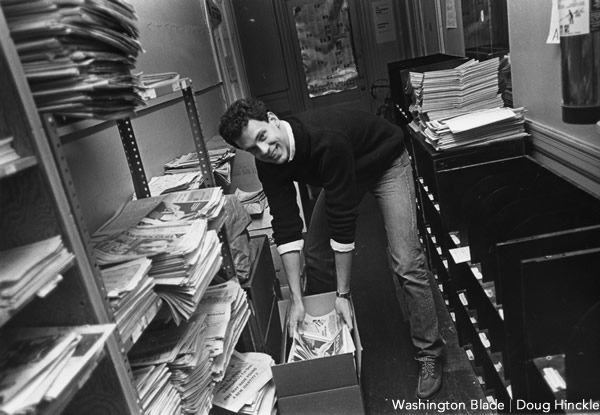
Crain was succeeded as executive editor by Kevin Naff, who remains the Blade’s editor today. In December 2007, Lynne Brown, who had worked for many years on the Blade’s advertising team, was named Blade publisher.
“It’s been a privilege to edit the Blade and help preserve its legacy of quality journalism as we’ve navigated the challenges facing the entire newspaper industry,” said Naff.
The Blade relocated from U Street to the National Press Building at 14th and F Street, N.W. in February 2008, bringing it to a location where many of the nation’s most prestigious news media outlets had their Washington news bureaus.
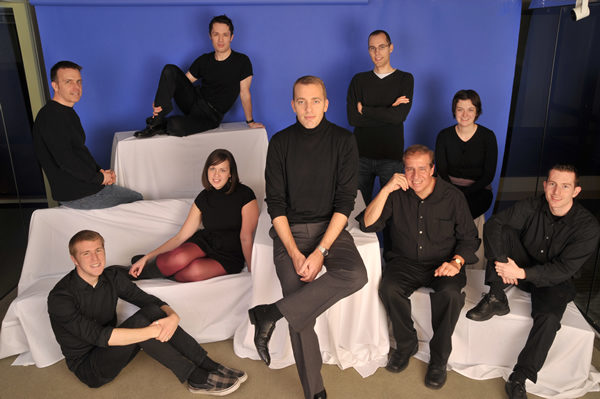
But less than two years later, in November 2009, Window Media’s parent company filed for Chapter 7 bankruptcy, resulting in the shutdown of the Blade and the other LGBT publications owned by Window Media. However, just four days later, the Blade’s staff, which banded together as volunteers, took the extraordinary step of creating a temporary replacement for the Blade called the D.C. Agenda and published its first issue.
Through financial support from loyal advertisers and readers, the former Blade staffers continued to publish the D.C. Agenda as a weekly placeholder until former publisher Brown, former editor Naff, and the Blade’s former advertising executive, Brian Pitts, formed a business partnership that purchased the Blade’s assets from the bankruptcy court.
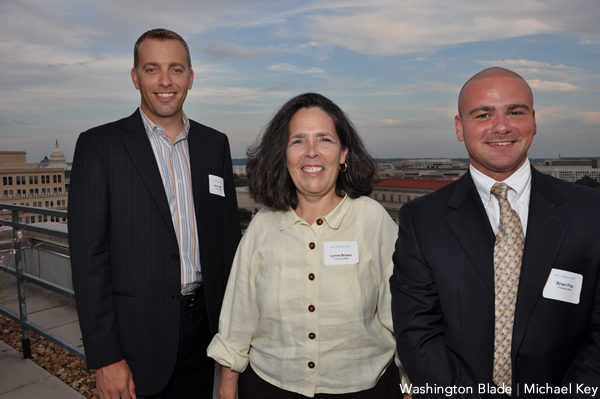
The three partners created a new parent company, Brown Naff Pitts Omnimedia, and relaunched the Washington Blade brand in April 2010. The new company opened its offices at 1712 14th St., N.W., the Blade’s current headquarters.
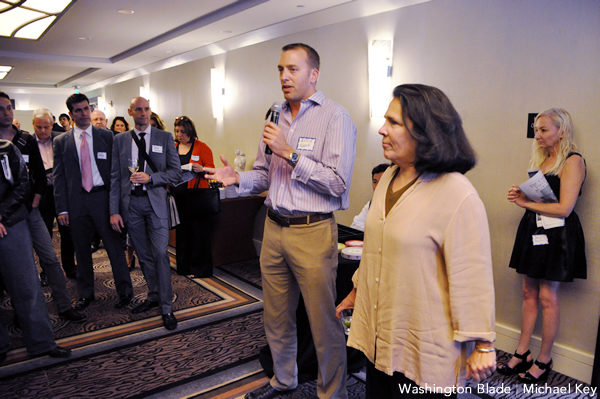
In October 2010, the Washington Blade Foundation, a new 501(c)3 nonprofit organization, was formed to raise money to digitize the full Blade archives. In January 2011, Brown Naff Pitts Omnimedia launched a new business unit, Azer Creative as a boutique marketing firm. And in March 2017, BNPO launched the Los Angeles Blade, a sister LGBT newspaper headed by publisher Troy Masters and veteran journalist Karen Ocamb as news editor.
Recollections by former Blade leaders
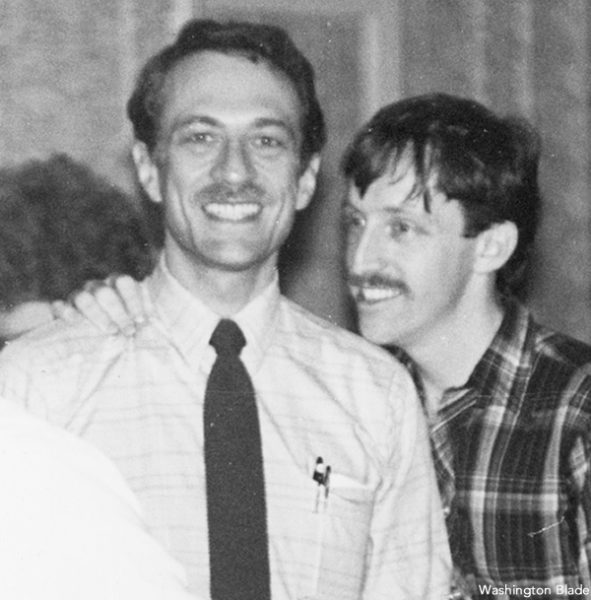
“I still live in D.C. and treasure a 45+ year relationship with John Yanson, who in the early days of the Blade was the staff photographer,” Michaels said when asked what he’s been doing since leaving the Blade. He and Yanson also spend time in San Diego, Calif., where they own a condo, he said.
Michaels was quick to reply to the question of what he most remembers about the Blade during his years working there.
“How eager our community was for a publication that focused on news and features rather than sexually oriented content,” he said. “Our approach attracted many really dedicated staffers who worked hard and tirelessly to make the paper grow from those 24-page monthly editions way back when into a well-regarded weekly newspaper of record.”
Keen, who had worked on the Blade staff for 20 years before leaving in 2001 as executive editor, said her years at the paper left a lasting impression.
“I remember a team of really dedicated colleagues and intensely loyal readers,” she said. “Don Michaels articulated a vision of the paper as one that would strive to meet professional standards and serve the LGBT community,” said Keen.
“People who joined the staff shared that vision and commitment at a time when working at a ‘gay paper’ was very likely to diminish one’s future employment prospects,” she said. “They were courageous and tough as nails, fun and funny, talented and reliable.”
Keen said she and her spouse, Sheilah McCarthy, currently live in Wellesley, Mass., where Keen has been covering national legal and political news for several LGBT news outlets around the country, including her own KeenNewsService.com. The couple is raising a 15-year-old son, Sam Keen.
Former publisher Waybourn said he and his partner maintain a D.C. residence but spend most of their time in Virginia’s Shenandoah Valley. They own several businesses, including the Long View Gallery in D.C.
“It was a great time to be involved in D.C. media,” Waybourn said in discussing his tenure at the Blade. “I loved working with the staff and individuals I met through community groups and organizations, and still maintain friendships with the individuals I met through the Blade.”
Crain, the former executive editor, said he and Waybourn “look back with great pride” on the years the two worked at the Blade. He said their acquisition of the Blade in 2001 through Window Media took place “at the height of prominence in LGBTQ media” and enabled them to work with “a wonderful and talented staff to expand the paper’s local coverage, improve its production quality, grow its advertising base and dramatically increase its presence on the internet.”
Crain said by the mid-2000s the Blade was “facing the same challenge as print publications everywhere” such as the loss of classified advertising to the internet. But he said the Blade nevertheless remained profitable, even at the time after he and Waybourn left and the Window Media parent company declared bankruptcy.
“We were greatly pleased that the staff took up the mantle to carry on the Blade’s rich history, and we join in celebrating this terrific milestone,” Crain said.
a&e features
Doug Spearman takes his chance
‘Noah’s Arc: The Movie’ debuted on Paramount+ last month
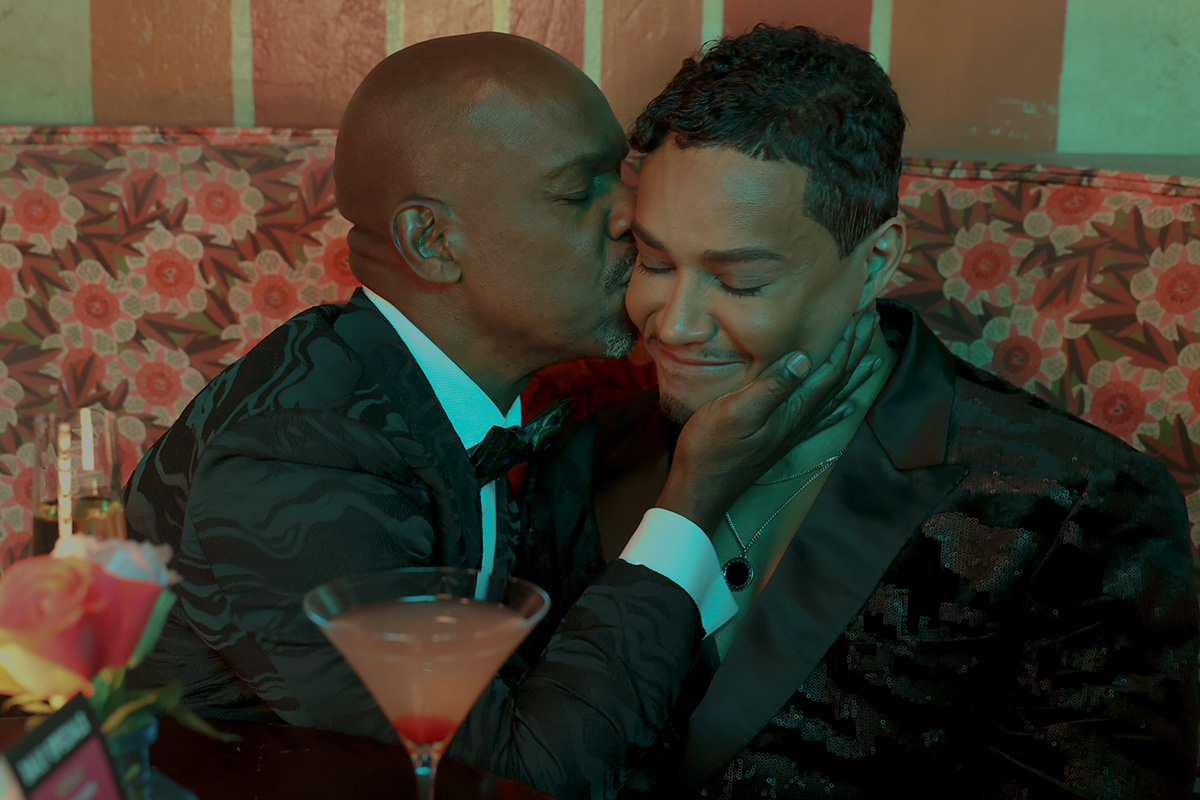
There’s no question that when Patrik-Ian Polk’s series “Noah’s Arc” premiered on Logo 20 years ago, it was a groundbreaking creation. The story of a group of Black gay men and their wonderful friendship. The titular arc was that of the cute main character, Noah (Darryl Stephens), and his close-knit circle of friends, including Chance played by gay actor Doug Spearman. This compelling and loving fraternity may, in fact, be what brought viewers back repeatedly, including a 2008 movie, “Noah’s Arc: Jumping the Broom,” as well as the 2020 “Noah’s Arc” short, and now, a new full-length feature “Noah’s Arc: The Movie,” debuting on Paramount+ on June 20. In the movie, filled with equal measures of laughs and tears, Chance, who has faced a devastating loss, finds his dependable friends there, ready to support and comfort him at a moment’s notice. I had the pleasure of speaking with Spearman the morning of the streaming premiere of “Noah’s Arc: The Movie.”
WASHINGTON BLADE: Doug, since the early 2000s, when the “Noah’s Arc” series premiered on Logo, you have been playing the character of Chance, including in the latest installment, “Noah’s Arc: The Movie.” What was it about Chance that appealed to you as an actor?
SPEARMAN: When Patrik (-Ian Polk) called me to ask me to play him (Chance), I was at JFK airport in the baggage claim, waiting for a suitcase. He explained what the part was. The thing that stuck out to me was the fact that Chance was in a long-term relationship with another Black man. And, they had a child; they had a 4-year-old daughter named Kenya. I had never seen two Black gay men raise a child on TV before. I thought it was the most revolutionary thing I’d ever seen. I immediately thought I’ve got to do this because that was something nobody had seen. I thought it was incredibly important to take the part.
BLADE: “Noah’s Arc: The Movie” was, once again, written and directed by Patrik-Ian Polk, who you just mentioned, is the creator of the entire franchise. What’s the secret to your long-standing working relationship?
SPEARMAN: [Laughs] the whole team, all of us, are like a band of brothers. We fight like brothers, we come together like brothers, we hash things out, we talk, because we’re all very different from our characters. I think the challenge of playing these guys and then uplifting these men, playing a part, especially something written by Patrik, is like solving a math equation. There’s always a challenge that’s enjoyable for me as an actor: to try to find out what it is that Patrik wants, and then how do I do it.
BLADE: I think you do a very good job of it.
SPEARMAN: Thank you very much
BLADE: In the years between “Jumping the Broom” and the new full-length movie, many changes have occurred, and the story addresses some of them, including gay widowhood, which is something that the aging community is now confronting, as well as mental health issues. Please say a few words about how you approached those subjects in the new movie.
SPEARMAN: I had a lot of loss in my life, right before we started shooting. Two months before we started shooting the first series, my mother died. I was going through the grief process through that whole first season. Since then, I’ve lost a lot of people in my life. In fact, when we started shooting the second season, the second week we were shooting, my ex died of a heart attack. I was having to fold that into what I was doing with my life on the set and off the set. You’ve got to show up and you’ve got to do your work. The first two seasons of “Noah’s Arc” are always tinged with the memory of grief. So, when I had to deal with the death that Chance faces (in the new movie), which is a significant death in his life, it wasn’t that hard to reach back, especially the scene in the graveyard. It was something that I unfortunately could pull from personal experience.
BLADE: Shifting gears, the movie features delightful cast surprises, including Jasmine Guy and TS Madison. Did you have a chance to interact with either or both when they were on set?
SPEARMAN: No, I didn’t have any scenes with Jasmine, and I missed her. I wish I had gotten to see her because I actually got to direct Jasmine for a CBS promo shoot for “Queen,” back in the early ‘90s. I had a huge crush on her when she was on “A Different World.” So, I really would have liked to reconnect. But TS and I got to see each other every day because I was in all her scenes. It was extraordinary being around somebody like that. That is one outspoken woman!
BLADE: Even though Beyoncé never makes an appearance in the movie, there’s a lot of talk about her. Would you say you are a Beyoncé fan?
SPEARMAN: Yes! I’m breathing! Yes, I’m a Beyoncé fan. I actually got the chance to meet her. I knew her mom. Her mom was extraordinary to me. She is in the second movie I directed. She also gave us a wedding gown to use in the very first scene of the movie. That family is extraordinarily important to me. Not only just to be a fan, but to be somebody who’s gotten to know them and work with them and see how hard they work. I don’t think anybody works as hard as Tina or Beyoncé.
BLADE: There was a recent news item about gay actor Benito Skinner of the Amazon Prime series “Overcompensating” being told not to bother auditioning for straight roles. As an out actor yourself, how important do you think it is for queer characters to be portrayed by queer actors, and vice versa?
SPEARMAN: Being queer is a multifaceted identity. There’s no one kind of queer person. I think finding the best actor that’s your first circle of casting. I think one of the joys about being an actor is that you get to play different parts. I play straight guys all the time. Dads and husbands and things like that. I think a lot of people are told not to do it. In fact, I wouldn’t be Chance if the actor who was originally cast as Chance hadn’t been pulled out of the series by his agents because they didn’t want him to play a gay character.
BLADE: That’s amazing! Thank you for sharing that. Without giving away too much, the ending of the movie is a little ambiguous, even ending with a question mark. If there was a “Noah’s Arc: The Movie” sequel, would you come back for that?
SPEARMAN: Yeah! A lot of it would depend on what Chance’s journey is going to be like. Patrik and I have conversations like that all the time. He’s very interested and supportive of input. I hope I would be, as we all would be, part of the creative growth with these characters. They live in Patrik’s head, and he writes them, but we’re the ones who have to flesh them out. It’s a conversation, it’s always a conversation.
BLADE: You are currently performing in Molière’s “The Imaginary Invalid” as part of the New Orleans Shakespeare Festival at Tulane. What has this experience been like for you?
SPEARMAN: It’s extraordinary! I started on stage when I was seven. There’s nothing like working with a live audience and having that immediacy. I’m working with an extraordinarily talented cast in a really great play, and I have some of the best scene partners I could ever want.
BLADE: Are there any upcoming film or TV projects you’d like to mention?
SPEARMAN: I’m still a writer, and I’m still a director, and I’ve still got scripts that I would like to make. I have a little something that’s a cross between “Treme” and “Bridgerton” that I want to do. I’m always trying to figure out what the next thing is.
a&e features
Visit Cambridge, a ‘beautiful secret’ on Maryland’s Eastern Shore
New organization promotes town’s welcoming vibe, LGBTQ inclusion
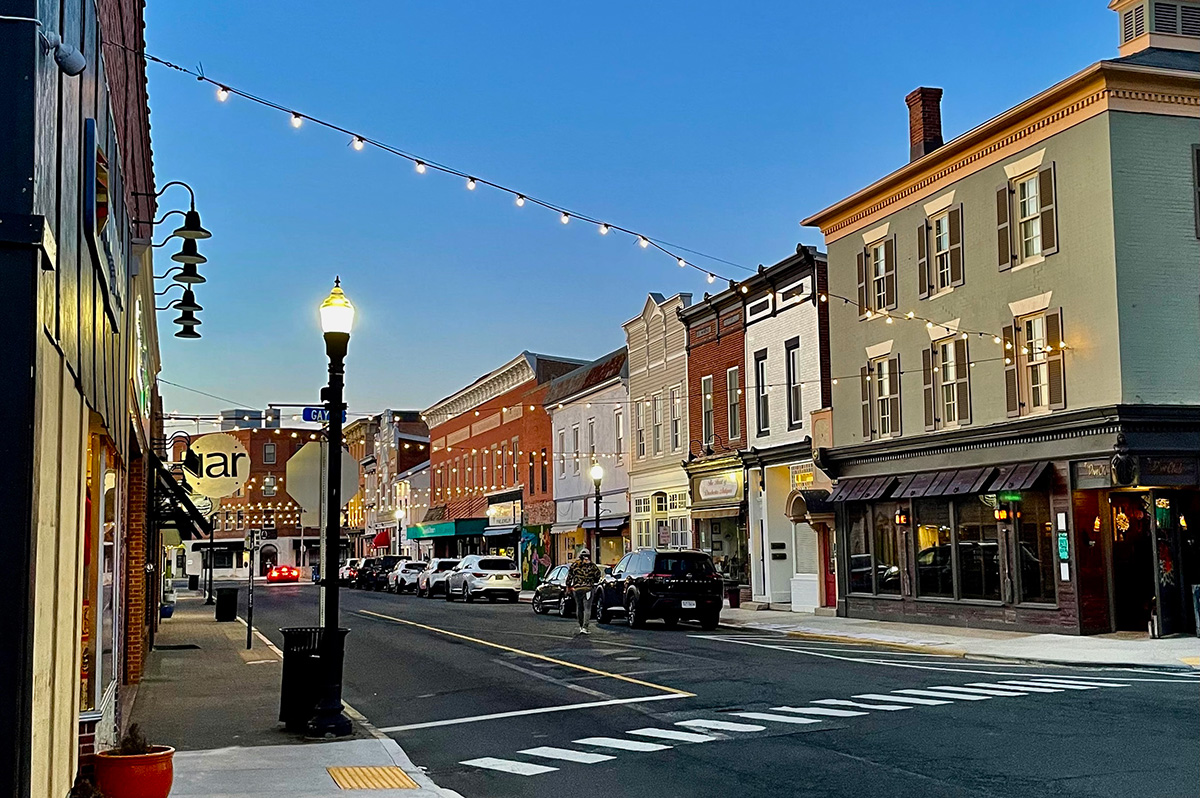
CAMBRIDGE, Md. — Driving through this scenic, historic town on Maryland’s Eastern Shore, you’ll be charmed by streets lined with unique shops, restaurants, and beautifully restored Victorian homes. You’ll also be struck by the number of LGBTQ Pride flags flying throughout the town.
The flags are a reassuring signal that everyone is welcome here, despite the town’s location in ruby red Dorchester County, which voted for Donald Trump over Kamala Harris by a lopsided margin. But don’t let that deter you from visiting. A new organization, Proudly Cambridge, is holding its debut Pride event this weekend, touting the town’s welcoming, inclusive culture.
“We stumbled on a beautiful secret and we wanted to help get the word out,” said James Lumalcuri of the effort to create Proudly Cambridge.
The organization celebrates diversity, enhances public spaces, and seeks to uplift all that Cambridge has to share, according to its mission statement, under the tagline “You Belong Here.”
The group has so far held informal movie nights and a picnic and garden party; the launch party is June 28 at the Cambridge Yacht Club, which will feature a Pride celebration and tea dance. The event’s 75 tickets sold out quickly and proceeds benefit DoCo Pride.
“Tickets went faster than we imagined and we’re bummed we can’t welcome everyone who wanted to come,” Lumalcuri said, adding that organizers plan to make “Cheers on the Choptank” an annual event with added capacity next year.
One of the group’s first projects was to distribute free Pride flags to anyone who requested one and the result is a visually striking display of a large number of flags flying all over town. Up next: Proudly Cambridge plans to roll out a program offering affirming businesses rainbow crab stickers to show their inclusiveness and LGBTQ support. The group also wants to engage with potential visitors and homebuyers.
“We want to spread the word outside of Cambridge — in D.C. and Baltimore — who don’t know about Cambridge,” Lumalcuri said. “We want them to come and know we are a safe haven. You can exist here and feel comfortable and supported by neighbors in a way that we didn’t anticipate when we moved here.”
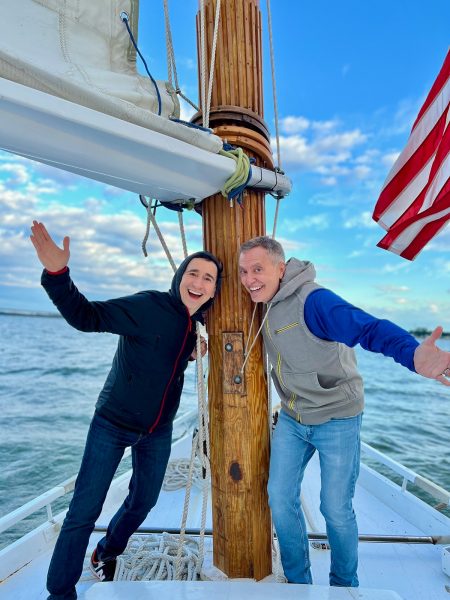
Lumalcuri, 53, a federal government employee, and his husband, Lou Cardenas, 62, a Realtor, purchased a Victorian house in Cambridge in 2021 and embarked on an extensive renovation. The couple also owns a home in Adams Morgan in D.C.
“We saw the opportunity here and wanted to share it with others,” Cardenas said. “There’s lots of housing inventory in the $300-400,000 range … we’re not here to gentrify people out of town because a lot of these homes are just empty and need to be fixed up and we’re happy to be a part of that.”
Lumalcuri was talking with friends one Sunday last year at the gazebo (affectionately known as the “gayzebo” by locals) at the Yacht Club and the idea for Proudly Cambridge was born. The founding board members are Lumalcuri, Corey van Vlymen, Brian Orjuela, Lauren Mross, and Caleb Holland. The group is currently working toward forming a 501(c)3.
“We need visibility and support for those who need it,” Mross said. “We started making lists of what we wanted to do and the five of us ran with it. We started meeting weekly and solidified what we wanted to do.”
Mross, 50, a brand strategist and web designer, moved to Cambridge from Atlanta with her wife three years ago. They knew they wanted to be near the water and farther north and began researching their options when they discovered Cambridge.
“I had not heard of Cambridge but the location seemed perfect,” she said. “I pointed on a map and said this is where we’re going to move.”
The couple packed up, bought a camper trailer and parked it in different campsites but kept coming back to Cambridge.
“I didn’t know how right it was until we moved here,” she said. “It’s the most welcoming place … there’s an energy vortex here – how did so many cool, progressive people end up in one place?”
Corey van Vlymen and his husband live in D.C. and were looking for a second home. They considered Lost River, W.Va., but decided they preferred to be on the water.
“We looked at a map on both sides of the bay and came to Cambridge on a Saturday and bought a house that day,” said van Vlymen, 39, a senior scientist at Booz Allen Hamilton. They’ve owned in Cambridge for two years.
They were drawn to Cambridge due to its location on the water, the affordable housing inventory, and its proximity to D.C.; it’s about an hour and 20 minutes away.
Now, through the work of Proudly Cambridge, they hope to highlight the town’s many attributes to residents and visitors alike.
“Something we all agree on is there’s a perception problem for Cambridge and a lack of awareness,” van Vlymen said. “If you tell someone you’re going to Cambridge, chances are they think, ‘England or Massachusetts?’”
He cited the affordability and the opportunity to save older, historic homes as a big draw for buyers.
“It’s all about celebrating all the things that make Cambridge great,” Mross added. “Our monthly social events are joyful and celebratory.” A recent game night drew about 70 people.
She noted that the goal is not to gentrify the town and push longtime residents out, but to uplift all the people who are already there while welcoming new visitors and future residents.
They also noted that Proudly Cambridge does not seek to supplant existing Pride-focused organizations. Dorchester County Pride organizes countywide Pride events and Delmarva Pride was held in nearby Easton two weeks ago.
“We celebrate all diversity but are gay powered and gay led,” Mross noted.
To learn more about Proudly Cambridge, visit the group on Facebook and Instagram.
What to see and do
Cambridge, located 13 miles up the Choptank River from the Chesapeake Bay, has a population of roughly 15,000. It was settled in 1684 and named for the English university town in 1686. It is home to the Harriet Tubman Museum, mural, and monument. Its proximity to the Blackwater National Wildlife Refuge makes it a popular stop for birders, drawn to more than 27,000 acres of marshland dubbed “the Everglades of the north.”
The refuge is walkable, bikeable, and driveable, making it an accessible attraction for all. There are kayaking and biking tours through Blackwater Adventures (blackwateradventuresmd.com).
Back in town, take a stroll along the water and through historic downtown and admire the architecture. Take in the striking Harriet Tubman mural (424 Race St.). Shop in the many local boutiques, and don’t miss the gay-owned Shorelife Home and Gifts (421 Race St.), filled with stylish coastal décor items.
Stop for breakfast or lunch at Black Water Bakery (429 Race St.), which offers a full compliment of coffee drinks along with a build-your-own mimosa bar and a full menu of creative cocktails.
The Cambridge Yacht Club (1 Mill St.) is always bustling but you need to be a member to get in. Snapper’s on the water is temporarily closed for renovations. RaR Brewing (rarbrewing.com) is popular for craft beers served in an 80-year-old former pool hall and bowling alley. The menu offers burgers, wings, and other bar fare.
For dinner or wine, don’t miss the fantastic Vintage 414 (414 Race St.), which offers lunch, dinner, wine tasting events, specialty foods, and a large selection of wines. The homemade cheddar crackers, inventive flatbreads, and creative desserts (citrus olive oil cake, carrot cake trifle) were a hit on a recent visit.
Also nearby is Ava’s (305 High St.), a regional chain offering outstanding Italian dishes, pizzas, and more.
For something off the beaten path, visit Emily’s Produce (22143 Church Creek Rd.) for its nursery, produce, and prepared meals.
“Ten minutes into the sticks there’s a place called Emily’s Produce, where you can pay $5 and walk through a field and pick sunflowers, blueberries, you can feed the goats … and they have great food,” van Vlymen said.
As for accommodations, there’s the Hyatt Regency Chesapeake Bay (100 Heron Blvd. at Route 50), a resort complex with golf course, spa, and marina. Otherwise, check out Airbnb and VRBO for short-term rentals closer to downtown.
Its proximity to D.C. and Baltimore makes Cambridge an ideal weekend getaway. The large LGBTQ population is welcoming and they are happy to talk up their town and show you around.
“There’s a closeness among the neighbors that I wasn’t feeling in D.C.,” Lumalcuri said. “We look after each other.”
a&e features
James Baldwin bio shows how much of his life is revealed in his work
‘A Love Story’ is first major book on acclaimed author’s life in 30 years

‘Baldwin: A Love Story’
By Nicholas Boggs
c.2025, FSG
$35/704 pages
“Baldwin: A Love Story” is a sympathetic biography, the first major one in 30 years, of acclaimed Black gay writer James Baldwin. Drawing on Baldwin’s fiction, essays, and letters, Nicolas Boggs, a white writer who rediscovered and co-edited a new edition of a long-lost Baldwin book, explores Baldwin’s life and work through focusing on his lovers, mentors, and inspirations.
The book begins with a quick look at Baldwin’s childhood in Harlem, and his difficult relationship with his religious, angry stepfather. Baldwin’s experience with Orilla Miller, a white teacher who encouraged the boy’s writing and took him to plays and movies, even against his father’s wishes, helped shape his life and tempered his feelings toward white people. When Baldwin later joined a church and became a child preacher, though, he felt conflicted between academic success and religious demands, even denouncing Miller at one point. In a fascinating late essay, Baldwin also described his teenage sexual relationship with a mobster, who showed him off in public.
Baldwin’s romantic life was complicated, as he preferred men who were not outwardly gay. Indeed, many would marry women and have children while also involved with Baldwin. Still, they would often remain friends and enabled Baldwin’s work. Lucien Happersberger, who met Baldwin while both were living in Paris, sent him to a Swiss village, where he wrote his first novel, “Go Tell It on the Mountain,” as well as an essay, “Stranger in the Village,” about the oddness of being the first Black person many villagers had ever seen. Baldwin met Turkish actor Engin Cezzar in New York at the Actors’ Studio; Baldwin later spent time in Istanbul with Cezzar and his wife, finishing “Another Country” and directing a controversial play about Turkish prisoners that depicted sexuality and gender.
Baldwin collaborated with French artist Yoran Cazac on a children’s book, which later vanished. Boggs writes of his excitement about coming across this book while a student at Yale and how he later interviewed Cazac and his wife while also republishing the book. Baldwin also had many tumultuous sexual relationships with young men whom he tried to mentor and shape, most of which led to drama and despair.
The book carefully examines Baldwin’s development as a writer. “Go Tell It on the Mountain” draws heavily on his early life, giving subtle signs of the main character John’s sexuality, while “Giovanni’s Room” bravely and openly shows a homosexual relationship, highly controversial at the time. “If Beale Street Could Talk” features a woman as its main character and narrator, the first time Baldwin wrote fully through a woman’s perspective. His essays feel deeply personal, even if they do not reveal everything; Lucian is the unnamed visiting friend in one who the police briefly detained along with Baldwin. He found New York too distracting to write, spending his time there with friends and family or on business. He was close friends with modernist painter Beauford Delaney, also gay, who helped Baldwin see that a Black man could thrive as an artist. Delaney would later move to France, staying near Baldwin’s home.
An epilogue has Boggs writing about encountering Baldwin’s work as one of the few white students in a majority-Black school. It helpfully reminds us that Baldwin connects to all who feel different, no matter their race, sexuality, gender, or class. A well-written, easy-flowing biography, with many excerpts from Baldwin’s writing, it shows how much of his life is revealed in his work. Let’s hope it encourages reading the work, either again or for the first time.
-

 U.S. Supreme Court3 days ago
U.S. Supreme Court3 days agoSupreme Court to consider bans on trans athletes in school sports
-

 Out & About3 days ago
Out & About3 days agoCelebrate the Fourth of July the gay way!
-

 Virginia3 days ago
Virginia3 days agoVa. court allows conversion therapy despite law banning it
-
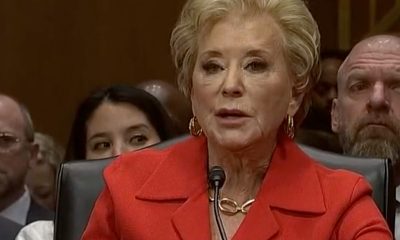
 Federal Government5 days ago
Federal Government5 days agoUPenn erases Lia Thomas’s records as part of settlement with White House

